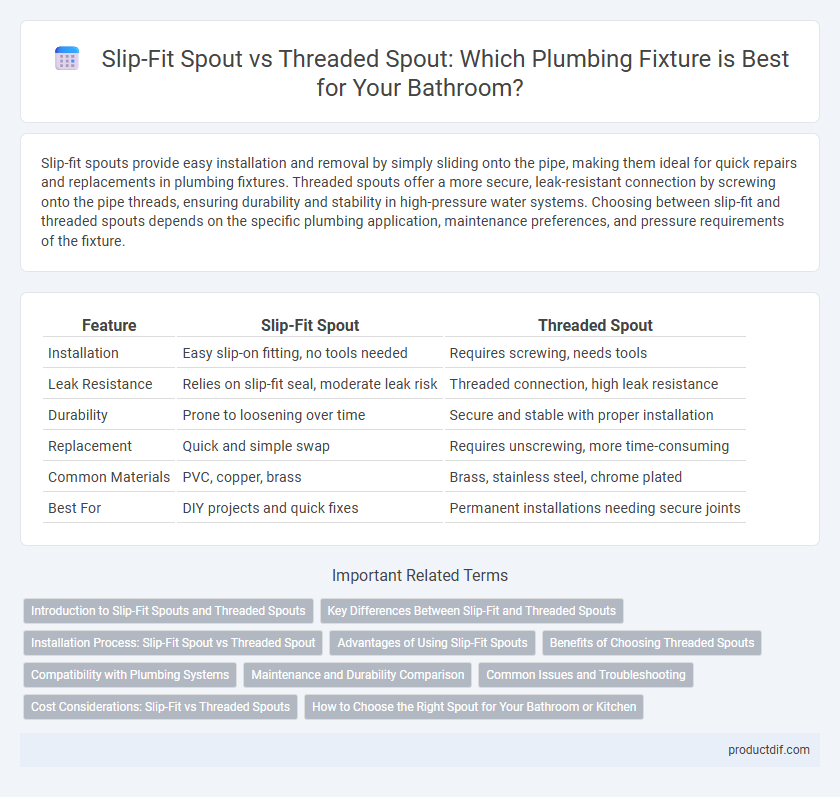Slip-fit spouts provide easy installation and removal by simply sliding onto the pipe, making them ideal for quick repairs and replacements in plumbing fixtures. Threaded spouts offer a more secure, leak-resistant connection by screwing onto the pipe threads, ensuring durability and stability in high-pressure water systems. Choosing between slip-fit and threaded spouts depends on the specific plumbing application, maintenance preferences, and pressure requirements of the fixture.
Table of Comparison
| Feature | Slip-Fit Spout | Threaded Spout |
|---|---|---|
| Installation | Easy slip-on fitting, no tools needed | Requires screwing, needs tools |
| Leak Resistance | Relies on slip-fit seal, moderate leak risk | Threaded connection, high leak resistance |
| Durability | Prone to loosening over time | Secure and stable with proper installation |
| Replacement | Quick and simple swap | Requires unscrewing, more time-consuming |
| Common Materials | PVC, copper, brass | Brass, stainless steel, chrome plated |
| Best For | DIY projects and quick fixes | Permanent installations needing secure joints |
Introduction to Slip-Fit Spouts and Threaded Spouts
Slip-fit spouts connect to plumbing pipes using a smooth, slip-on design secured with solder or adhesive, allowing for a seamless and leak-resistant joint ideal for copper or plastic tubing. Threaded spouts feature a screw-in connection with threaded fittings that provide a secure and easily detachable assembly, commonly used in metal piping systems such as galvanized steel or brass. Choosing between slip-fit and threaded spouts depends on pipe material compatibility, installation preferences, and maintenance requirements.
Key Differences Between Slip-Fit and Threaded Spouts
Slip-fit spouts offer a simple installation by sliding directly onto the pipe and securing with a set screw, ideal for quick repairs or replacements. Threaded spouts provide a more secure and durable connection by screwing onto threaded pipe ends, ensuring a watertight seal suitable for high-pressure systems. The choice between slip-fit and threaded spouts depends on installation ease, durability requirements, and compatibility with existing plumbing setups.
Installation Process: Slip-Fit Spout vs Threaded Spout
Slip-fit spouts offer a streamlined installation process by sliding directly over the pipe and securing with set screws, eliminating the need for precise threading. Threaded spouts require careful alignment and tightening onto threaded pipes, which can increase installation time and the risk of leaks if not properly sealed with plumber's tape or sealant. Choosing slip-fit spouts can significantly reduce labor and error during plumbing fixture setup compared to threaded spouts.
Advantages of Using Slip-Fit Spouts
Slip-fit spouts offer effortless installation by simply sliding over the pipe, reducing the need for precise threading and specialized tools. Their design minimizes the risk of leaks by creating a tight, gasket-sealed connection that enhances durability and water-tight performance. Maintenance is simpler with slip-fit spouts, as they can be easily removed or replaced without disassembling threaded joints, saving time and reducing labor costs.
Benefits of Choosing Threaded Spouts
Threaded spouts provide a secure and leak-resistant connection, ensuring long-lasting durability in plumbing fixtures. Their compatibility with various pipe sizes and types allows for versatile installation options in both residential and commercial settings. Maintenance and replacement are simplified due to the easy detachment of threaded spouts without the risk of damaging adjacent components.
Compatibility with Plumbing Systems
Slip-fit spouts offer superior compatibility with modern plumbing systems by providing a smooth, press-fit connection that minimizes leaks and simplifies installation, especially in copper or PEX piping setups. Threaded spouts require precise threading and sealants, making them more suitable for traditional metal pipe systems but less adaptable to flexible or plastic piping. Choosing between slip-fit and threaded spouts depends largely on pipe material and installation preference, with slip-fit spouts favored for their ease and leak resistance in contemporary plumbing configurations.
Maintenance and Durability Comparison
Slip-fit spouts offer easier maintenance due to their simple installation, allowing quick removal and replacement without specialized tools. Threaded spouts provide enhanced durability and a secure connection, reducing the risk of leaks under high pressure or frequent use. For long-term performance, the choice depends on balancing the convenience of slip-fit designs with the robust sealing advantages of threaded models.
Common Issues and Troubleshooting
Slip-fit spouts often face issues like water leakage caused by loose fittings or damaged O-rings, while threaded spouts commonly encounter problems such as cross-threading or corrosion affecting the connection. Troubleshooting slip-fit spouts involves tightening the retaining set screw and replacing worn seals, whereas threaded spouts require careful removal to avoid stripping threads and application of plumber's tape for a secure, leak-free seal. Both types benefit from regular inspection and maintenance to prevent common fitting failures and ensure reliable water flow.
Cost Considerations: Slip-Fit vs Threaded Spouts
Slip-fit spouts generally offer a lower upfront cost due to simpler installation and fewer required tools, making them ideal for budget-conscious plumbing projects. Threaded spouts, while typically more expensive initially, provide enhanced durability and a more secure fit, potentially reducing long-term maintenance expenses. Evaluating total cost of ownership, including installation labor and future repairs, is essential when choosing between slip-fit and threaded plumbing spouts.
How to Choose the Right Spout for Your Bathroom or Kitchen
Selecting the right spout for your bathroom or kitchen hinges on understanding the installation type and compatibility with existing plumbing. Slip-fit spouts offer easy installation over a pipe without threading, ideal for quick repairs or replacements, while threaded spouts require screwing onto a threaded pipe, providing a more secure and leak-resistant connection. Consider the pipe type, ease of installation, and the desired durability to ensure optimal performance and a leak-free experience.
Slip-Fit Spout vs Threaded Spout Infographic

 productdif.com
productdif.com